Headlines of the Day
CEO CONCLAVE-BRIDGING THE DIGITAL DIVIDE
India Mobile Congress, India’s largest digital technology event saw an overwhelming participation from global industry behemoths and deliberated on a wide spectrum of topics.
The keynotes for this session were delivered by Bruce McClelland, President and Chief Executive Officer, Ribbon Communications and Dr. Ajay Kumar (IAS), Union Defence Secretary.
The Fireside Chat was between Darren Yong, Executive Director, ASPAC Head for Technology, Media and Telecommunications, KPMG Asia Pacific and Sanjay Kaul, President, Asia Pacific, and Japan, Service Provider Business, Cisco Systems, Inc.
The panel discussion was held amongst Ankit Agarwal, Chief Executive Officer, Connectivity Solutions, STL; Sanjay Malik, Senior Vice President and Head of the India Market, Nokia; Sanjeev Bedekar, Chief Executive Officer, Ranext Technologies Pvt. Ltd.; Dr. Magnus Ewerbring, Chief Technology Officer APAC, South East Asia, Oceania and India., Ericsson; and Marshal Correia, Vice President & Managing Director, India/SA, Red Hat Inc. The discussion was moderated by Alex Holt, Global Head for Technology, Media and Telecommunications and Partner, KPMG.
KEYNOTE ADDRESS
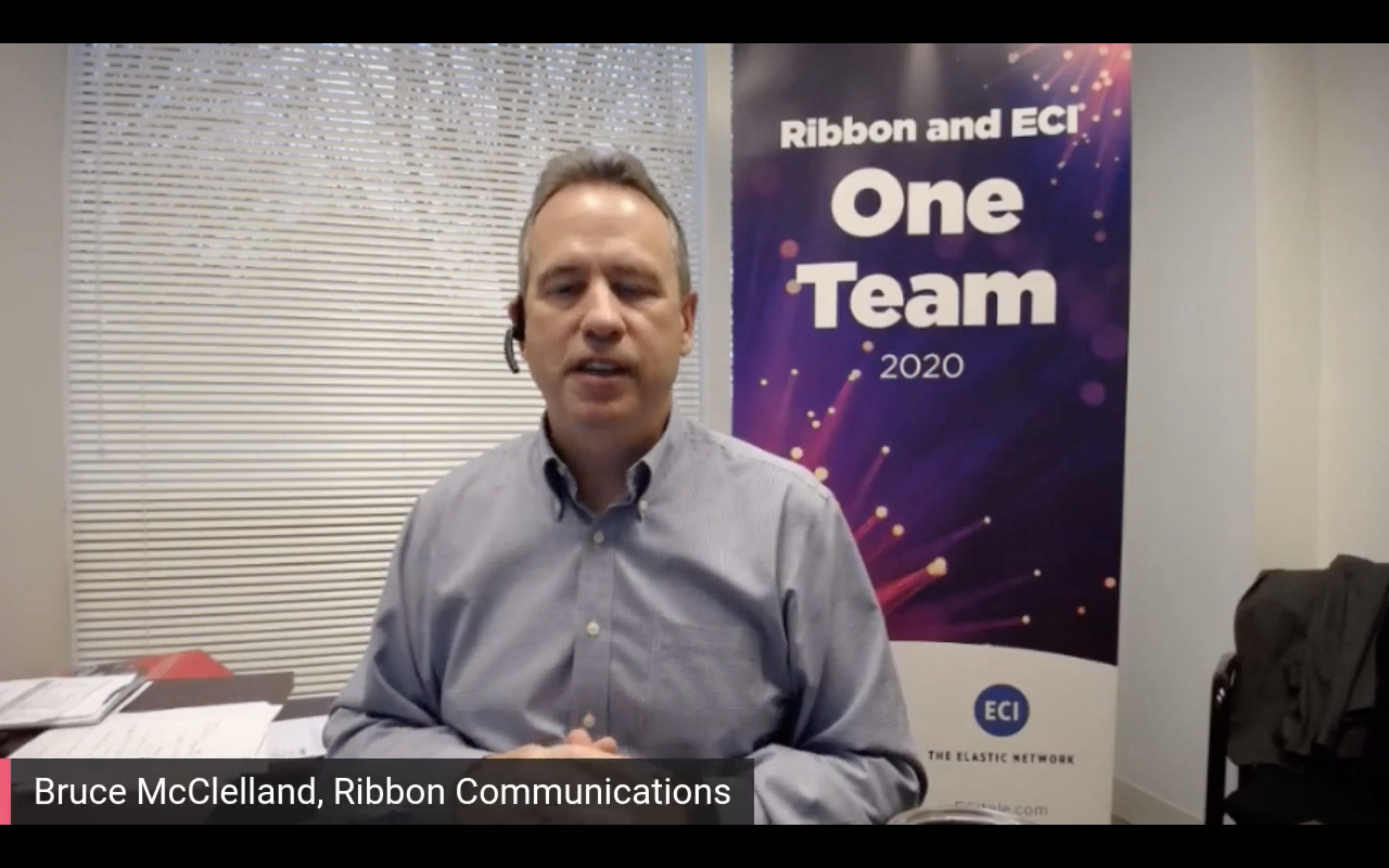 Bruce McClelland. “As we continue to manage through the COVID crisis, it seems very appropriate to focus my presentation on the network itself, and really being a solution for bridging the divide. It’s really a powerful, disruptive force for service providers.
Bruce McClelland. “As we continue to manage through the COVID crisis, it seems very appropriate to focus my presentation on the network itself, and really being a solution for bridging the divide. It’s really a powerful, disruptive force for service providers.
This year, we’ve all been managing disruption both personally and professionally, that we really couldn’t have imagined or anticipated. But when it comes to providing critical communications, it’s been amazing to see how well the industry’s met the challenge this year.
And more than ever, how important, inclusive access and usage of the network is for all consumers and businesses. The resilience and the flexibility of the networks is really a strategic advantage.
Conversely, this can really work against you if you don’t stay diligent and stay ahead of the curve investing in anticipating future demands.
As you may be aware, earlier this year, Ribbon Communications merged with ECI Telecom, that expanded our focus into the optical networking space and IP solutions. While we’re a US based company, we have a significant presence in India and in the Asia Pacific region. In particular, our newly acquired company ECI has a very long, successful history in the Indian market. We work with many of the large carriers in the region, including Jio Airtel, Vodafone Idea, and Tata.
There have been significant changes in consumer behaviour this year, and most companies have moved to a work from home operating model. This resulted in huge increases in traffic in certain parts of the network. And in some cases, a big shift in traffic from the mobile network onto the fixed network.
Traffic patterns, application usage and the temporal usage throughout the day has changed dramatically. And, going forward post-COVID, this will continue to evolve as we move into a more hybrid work from home, work from office working model.
It has also highlighted the challenges we still have in providing unified access, and that we still have a very real digital divide. And how important both network architecture and technology selection are, and can affect the ability to react quickly through dramatic shifts in traffic and traffic patterns and different applications and need to really be able to quickly shift and address consumer demands.
Ultimately, the level of flexibility, reliability and scalability enabled by the network is a big differentiator and dictates consumer satisfaction and ultimately, financial results for the company.
Traffic dramatically surged across mobile and fixed networks around the world. In India too, consumption surged upwards of 30 percent on mobile broadband networks, forcing carriers to continue to add more capacity. And, while the country was in lockdown, it is very impressive how the telecom providers provided incredible service. Practically all businesses shifted overnight to a work from home model, creating skyrocketing demand for collaboration platforms and all forms of communication.
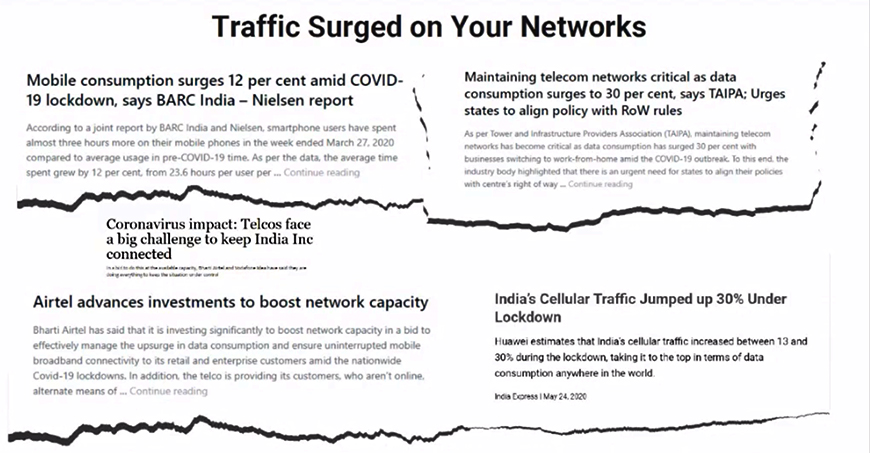
I would like to share a few examples of what we’ve seen around the world, highlight areas that we’re investing in, and enabling our customers to use their networks as powerful disruptors for their business, disrupting competition and ultimately gaining share.
First and foremost, it’s really hard to have too much raw capacity. Most network providers and operators have a variety of different predictive models to determine different triggers on when to add more network capacity and augment the network and to plan around peak network utilisation requirements.
Of course, this year all the predictions made earlier went haywire.
In the US with Verizon, we saw immediate shifts in traffic from the mobile network onto the fixed network, both in terms of data usage and voice usage. Voice call volumes spiked enormously peaking at over 800 million calls per day, doubling the highest peak day ever seen in a typical year. Call durations at the same time spiked enormously and with everyone being on conference calls, they increased by 33 percent over normal.
In the UK, BT had over 100 percent increase in daytime traffic on their broadband network. And mobile data usage dropped just modestly.
AT&T reported increases in many of their network metrics, but in particular large increases in calls from home, Both traditional landline calls as well as mobile Wi Fi calls.
Telefonica, Spain saw significant increases in data usage on both their fixed network which was up 26 percent, and in their mobile network, which was up 48 percent.
So a lot of similarities were seen across the world.
But many of the telecom providers also some differences in the types of traffic patterns. The information here from Verizon and AT&T highlights both the type of traffic that has changed as well as the quantity of traffic.
In the case of Verizon, connections from the home, back to the office, through VPN tunnels increased dramatically and increased 50 percent over pre COVID levels. And download usage and voice usage too increased substantially. Gaming traffic increasing more than 100 percent compared to prior-COVID. And these services have different requirements for the network- on the entire access network, aggregation, backhaul, interconnects are all affected differently depending on the type of traffic. And they all really require strong network planning and implementation. And ultimately, when done well, creates just great customer loyalty.
We have all jumped, maybe five to ten years into the future in the adoption of online collaboration platforms such as Zoom and Microsoft Teams. And even as we return to the office and move into sort of a hybrid operating model, the usage of the collaboration platforms are here to stay and have become an integral part of how we communicate, and ultimately will replace traditional private phone systems.
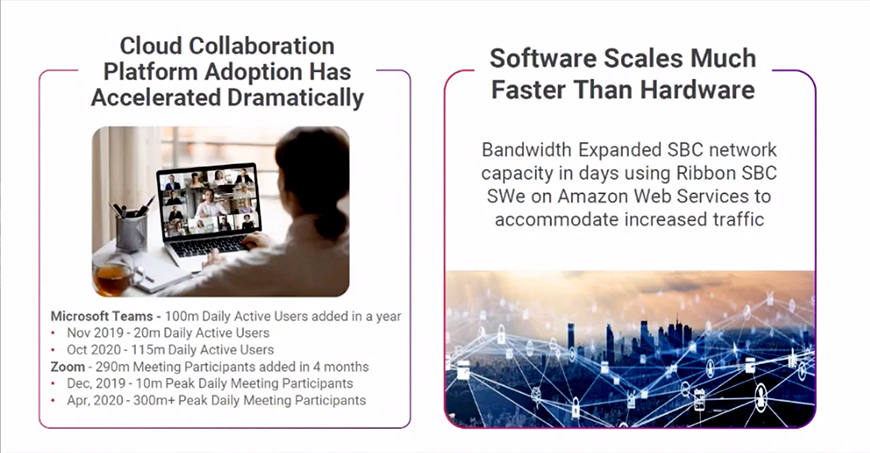
Both Zoom and Microsoft Teams are deployed, leveraging a cloud centric deployment model, connected back to the traditional landline phone network via standard SIP interfaces. And these new ways of communicating are here to stay. In fact, deployments will expand as they replace traditional interview enterprise phone systems.
And of course, all software runs on hardware. But being able to use commercial off-the-shelf computing storage greatly improves flexibility. And advances in multicore computing and GPU accelerators means applications can run with similar levels of performance as custom hardware running on standard compute.
A great example of this in our business is this year when we partnered with Bandwidth Inc in the US. During the height of a surge in traffic from the work from home transition, we needed to rapidly expand SIP Trunking capacity and their network. And rather than deploying high performance computing resources on premise, we were able to quickly spin up capacity in AWS. And this type of private- public-cloud hybrid deployment model is something that many operators have now adopted, and is really a great way of enabling the elasticity to deal with surges in demand, as well as achieving an overall kind of lowest cost structure for the business.
At Ribbon to support our customers, at the core of the network, the vast majority of our products are now available in software-only versions, either as enterprise software running in a data centre, or cloud native implementations. Even traditional functions like high performance, voice codec processing, which typically has been implemented on dedicated DSP custom hardware is now available on standard GPU central computing platforms, which greatly simplifies capacity planning, software upgrades, and network management. In the case of transport, from an underlying kind of raw capacity perspective, you cannot virtualize that. And you cannot virtualize layer zero. We designed a lot of flexibility into our products to allow programmability and elasticity, and low latency to meet the evolving demands of different types of services that the platform has to support.
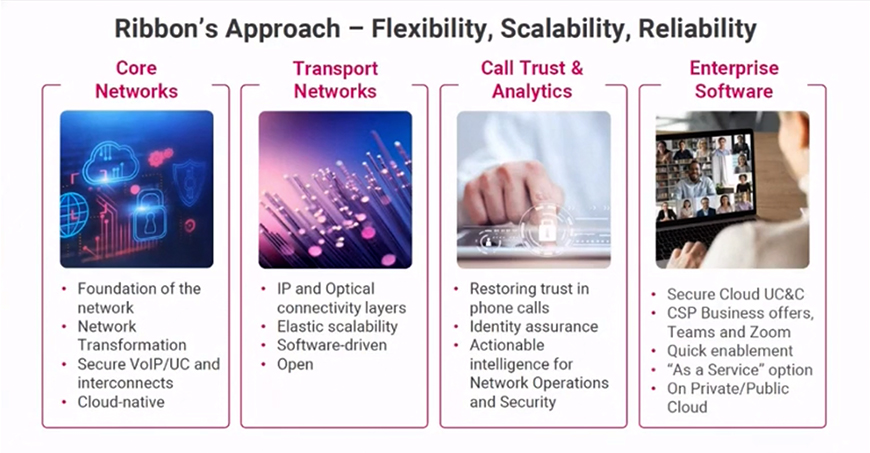
Ultimately, data is the gold dust sprinkled across the networks. And we put a lot of effort into a comprehensive analytics platform that can collect and process vast amounts of unstructured data across the network, and then present that for a variety of different purposes.
One great example, which gets a lot of attention in the US is the issue around nuisance, fraudulent, or robot calling, that seems to get worse every day, We are able to provide a great set of tools that provide the operator the ability to restore trust with consumers in the foundation of the phone system.
And with our enterprise customers, we have a complete set of solutions now, from on-premise all the way through to public cloud and as a service option that reduces the friction for deployment and provides a lot of elasticity and ultimately accelerating the time to revenue for our customers.
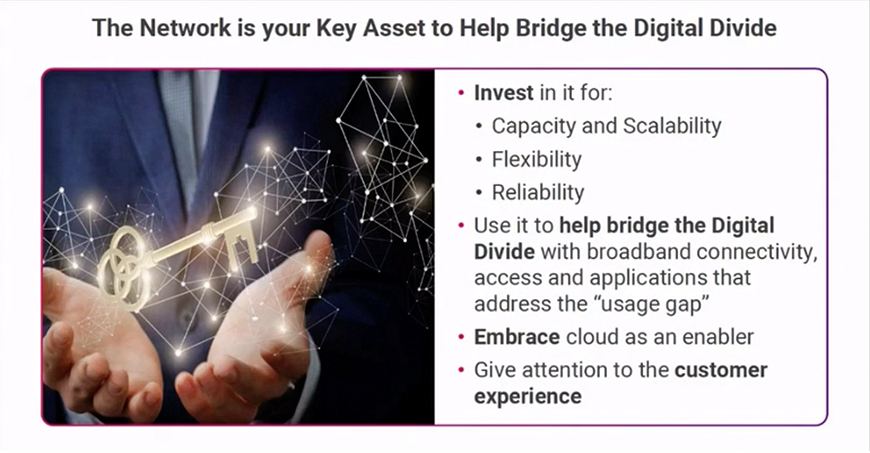
I firmly believe that the network is the key asset, a real weapon when dealing with the digital divide and ultimately helping disrupt competition, But to do that, there must be advanced thinking, investing into the future, maximising flexibility, scalability, reliability and ultimately capacity.
And the trends toward open networking and cloud are big enablers to make this happen and ultimately will increase customer loyalty and ultimately the success of your company.”
 Dr. Ajay Kumar (IAS), Union Defence Secretary “The mobile story in India has been a runaway success story, It has been the bedrock of Digital India.
Dr. Ajay Kumar (IAS), Union Defence Secretary “The mobile story in India has been a runaway success story, It has been the bedrock of Digital India.
Today, in the times of Corona, if India has been able to seamlessly move from a physical world to the digital world, it is because of the role played by the large scale penetration in the telecom sector. Whether it was online schools and colleges, e-commerce, online payment systems, work from home and all the other ways that we could move effortlessly from the physical into a virtual world, if today there is an Indian economy, which is not seeing a significant downtrend, it is the mobile sector that needs to be lauded.
India has a lot of stakes in various parts of the mobile ecosystem-the hardware, apps ecosystem, and the telecommunication ecosystem. I would like to particularly focus on the electronics hardware part.
I recollect, when in 2011, for the first time, the vision to create an Indian domestic electronics hardware industry was articulated, and we envisaged a USD 400 billion electronic hardware industry and a USD 100 billion export industry, a lot of knowledgeable people scoffed it off as virtually impossible.
Today, due to the progressive policies of Government of India, Make in India policy, Digital India policy and tremendously proactive support received from the industry, the electronic hardware industry is touching about USD 100 billion. Exports have been growing at an exponential rate, a phenomenal 33 percent year-on-year, and the recently introduced PLI policy is likely to give it further impetus. USD 400 billion and USD 100 billion dollars do not look so unreasonable today.
I salute all those people who have played a wonderful part, especially the industry leaders and champions and made this possible. In this success story of electronics hardware, when India is increasingly becoming a destination of choice for various electronics hardware manufacturing companies, whether it is Apple, Samsung, Wistron, Foxconn, to name a few, mobile particularly takes the cake. It comprises nearly 50 percent of the electronics hardware industry and is a huge part of the overall electronics hardware ecosystem.
I would also like to mention about the huge big possibilities which India is opening up to, as it starts moving in its journey toward 5G. For the first time, India is developing its own technologies for 5G. And several Indian players have created parts and subsystems, components and technologies, which will comprise of nearly 10-20 percent of the overall technologies required in the 5G ecosystem.
Jio has announced that it is coming in a big way in 5G technologies. I welcome all these players. From a national perspective, it is important that India has embarked on the journey where it is creating its own technologies in 5G. And who knows, by the time 6G comes, India could be a significant player in the technology arena for communication.
Also, India can play a very significant role in the services and apps that will be developed for 5G. By unique implementation of applications like Aadhar and government e- marketplace, India has demonstrated that we can develop new innovative applications, which are particularly relevant to the context in which we work and live, rather than apeing the applications that have been developed elsewhere in the world. And today, these solutions have become a model for the world. 5G offers an opportunity for Indian developers and promoters to create apps and solutions, for not only India, but a huge part of the developing world, whose context is similar to India. These are cost efficient, affordable, pervasive, and highly customised.
In the defence sector too, technology increasingly has a greater role to play. Under the Atmanirbhar Bharat mission, a huge amount of emphasis is being given to promote the private industry. Defence Acquisition Procedure 2020, which has been promulgated recently gives thrust, both to MSMEs and other startups, that are creating new technology in this sector.
We are moving from a world of transfer of technology and licensed production to creating our own innovations and technologies. And I am sure that as defence weaponry and equipment increasingly become digitalized, and use of smart unmanned technologies come into being, a huge opportunity to participate in the defence market, Indian and the huge global market, opens up for our technology players, software players and startups.
I invite the industry players to look and participate in the opportunities offered by the defence sector.”
FIRESIDE CHAT-Darren Yong and Sanjay Kaul
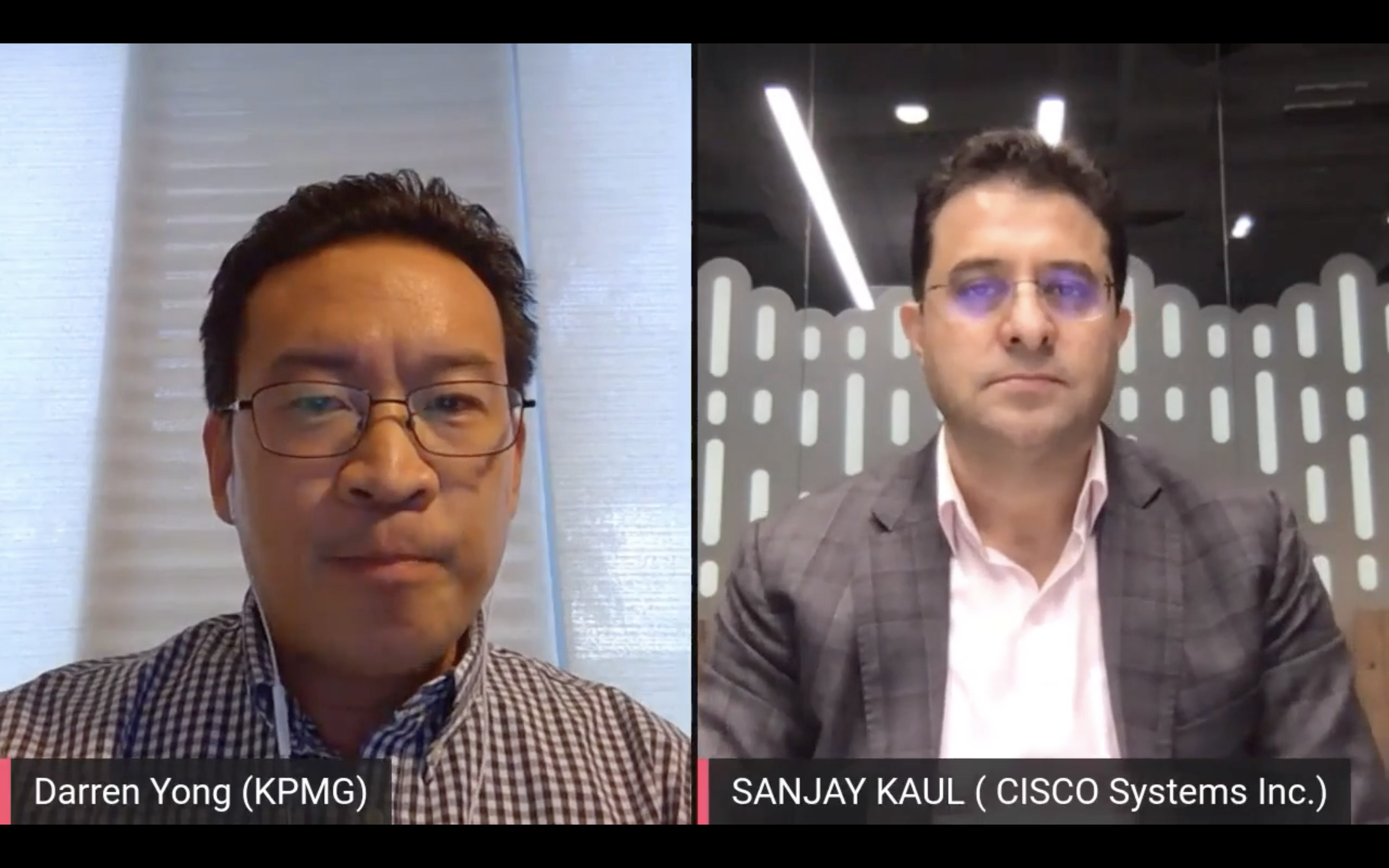
Darren Yong. “Big technology has really transformed the world. Developer companies, with access to technology have absolutely come out of the blue, these unicorns and become the biggest growth companies around the world. We have been looking at how potentially companies, smaller markets can leapfrog others because of technology. India, one of the outsourcing capitals of the world, has the ability to transform and leapfrog potential using technology with software and AI. Today I would like to talk on this sort of digital divide. And how you see technology impacting parts of rural countries or rural areas around the world.”
Sanjay Kaul. “Digital divide is not a myth. Only 29 out of 195 countries have affordable internet connection today. And only 50 percent women have access to internet. Thankfully, India is on the affordable side.
How can we bridge it? We are doing pretty well in the urban areas. But challenges remain in the rural areas. First priority would be getting internet access to everyone irrespective of where he is in the world.
Then creating and thriving an ecosystem, that can draw business out of this.
It is not just about making the internet connections possible. The ecosystem behind it has to survive and thrive.
India is a very good example, from the 120th position in broadband, we have reached position number one. But the lowest tariffs in the world does not create a sustainable business for those who are putting this infrastructure and making access possible.
As we pivot, post-COVID the force of digital will drive the companies. Adoption of technology, making industrial IoT real, bringing in automation, converging the networks, i.e. flattening and identifying the network, that takes a lot of cost out of the networks, a combination of all these will create a network architecture that will have a sustainable business case.
Yes, there is a divide. Yes, we have an opportunity to bridge in. Industry 4.0 execution will fund the case. But at the same time, industry will need to adopt the technologies that will make it very cost-effective and service agile in total.
We have seen it in a village in Kenya, first hand. Once you give access to internet, the children figure it out. We left some laptops there too, and when we came back, after two months, those kids were playing with the computer, they had figured it out and were very happy reading. And over time, some were able to code, applications and even launch solutions and products.
But it has to be sustainable. Else after just six months, the wi-fi access point provided is not even maintained, and no longer works.
Cannot expect the government to execute on the technology for the rural areas. That is the role of the private sector, the service providers plus the entire ecosystem behind it. The government needs to provide the right regulation and the policy framework.
The government of Philippines, for instance offers a very attractive 5G frequency structure. Its pretty unique. And now, that the telcos having conserved their resources, not having to pay for the spectrum are putting in the infrastructure.
The Indian government too needs to create a policy and regulatory structure that creates impetus for the service providers first and the ecosystem behind them to leapfrog and beat the developed world. All the ingredients are there.
It all starts with the government and the policymakers.
First creating the right framework, the right policy framework and the regulatory framework- that is step number one.
Step number two is at the service providers’ end, they are the rock-bed, the foundation for bridging the digital divide. They will need to transform their networks on all fronts. It will require a relook in current network architectures, which are very, very complex, as they were built in layers of 2G 2.5G, 3G, and 4G. Costs will have to be reduced to the last rupee to make it affordable for every citizen in the country to use the service. Data centre architecture too have been built like monolithic central data centres. Every bit in this network was brought back to the central repository. In industry 4.0 it’s all about instant gratification, the data needs to be captured as it gets produced. So that insights drawn out of it, security analytics applied and value extracted. Data processing has to be moved to the edge.
Third one, is what I call, uberisation of OSS/BSS that self-rectifies the billing etc, in line with instant gratification.
And the fourth one is security. Security should be front and central. It is not about having security firewalls in the network or in the data centre, you are as good as the last terminal that’s accessing the data. Security must be ubiquitous.
And the last one, is an agile business model from the technology providers. To bring in software-oriented products that are not proprietary but open.
A recently released Cisco report has revealed that if India executes on the digital mission that PM Modi has laid out, by 2030 25% of India’s GDP can accrue from digitization.”
PANEL DISCUSSION
 Alex Holt. “Connectivity and technology will play a pivotal role in the economic recovery that we’re hoping to see during 2021.
Alex Holt. “Connectivity and technology will play a pivotal role in the economic recovery that we’re hoping to see during 2021.
In India, enormous progress has been made on connectivity over a number of years. But there are still more than 600 million individuals without access to mobile broadband. It’s a significant opportunity
We have an enormous opportunity. I ask each panellist how their company can help bridge the digital divide.”
 Sanjay Malik. “The digital divide has drastically reduced since seven years back, when mobile broadband was basically based on xDSL, on 2G, and available to the urban population. As technology moved to 4G, from fibre to home, the digital divide came down drastically.
Sanjay Malik. “The digital divide has drastically reduced since seven years back, when mobile broadband was basically based on xDSL, on 2G, and available to the urban population. As technology moved to 4G, from fibre to home, the digital divide came down drastically.
While mobile broadband over the last five years, in urban population has moved by about 5x; in rural India, it has moved by 25x, from 10 million mobile broadband connection in rural India to 250 million, out of the total 700 million internet connections.
I do not agree that with the introduction of 5G services, that is mostly seen as for the urban population, the digital gap will widen. This same question, was asked when 4G was introduced.
Once 5G or any next generation technology come into the picture, it will further bridge the digital divide. The use cases or whatever are the enabler will be there for rural India, whether it is remote health, remote education, or others.
And Nokia has a large role to play here. We would be providing the 5G technology and all associated with it, be it the analytics tools, machine learning, and other aspects required to take India to the 5G journey.”
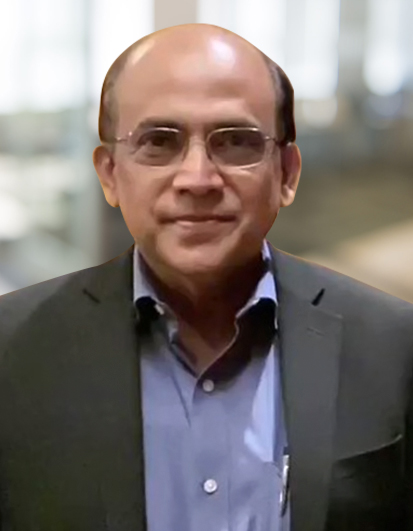 Marshal Correia. “Technology helps bridge the digital divide. Look at the tremendous progress that India has made over the years, from 2G to 3G to 4G, to 1160 million mobile subscribers, 455 million internet users, and 400 million smartphones.
Marshal Correia. “Technology helps bridge the digital divide. Look at the tremendous progress that India has made over the years, from 2G to 3G to 4G, to 1160 million mobile subscribers, 455 million internet users, and 400 million smartphones.
ICT is the basic foundation on which the economy rests. Look at the progress India has made in terms of unified payments. And digital transformation has accelerated in COVID times.
The telcos have done an amazing job. And while it started from working from home, now the possibility is working from anywhere. Financial inclusion is another big step. India had a huge unbanked population, they were given access to banking facilities.
A lot of innovation needed to happen. The government introduced support systems in many areas. The digital divide is not just about ICT, other factors, as digital literacy are broader issues. And there are force opportunities and challenges, which we can work on. It offers big opportunity.
5G brings speed, latency, and a huge bandwidth. And as we move to Atmanirbhar Bharat, Industry 4.0, AI, ML, it is a tremendous opportunity.”
 Dr. Magnus Ewerbring.“ 5G is a fantastic opportunity, alongwith 4G, of course.
Dr. Magnus Ewerbring.“ 5G is a fantastic opportunity, alongwith 4G, of course.
In the Mobility Report released by Ericsson recently, the five year prediction says in 2026, there will be 3.5 billion 5G subscriptions in the world and 27 percent of all the subscriptions in India will be 5G.. And 95% population will have 4G coverage.
Perhaps the most impressive are the smartphone subscriptions numbers predicted for India. Until 2026, 530 million new subscriptions will be added in India alone, summing up to almost 1.2 billion in total. That is a fantastic pace for being connected and being digital, for individuals and for business. It will change society for the good.
COVID has accelerated this movement. Working from home during the lockdown has made way for working from anywhere. And the systems are coping well with it.
The same follows for remote shopping of essentials like groceries, and E-health. This is a trend that will stay. People are getting used to new behaviour of organising their life. And they will want to continue that. And even so more so with 5G, that gives the highest performance.
The industries and enterprises too are digitalising fast. Assessing 10 different segments, we predict the value for mobile operators as USD 17 billion additional revenue from India alone by 2030. There is a great potential for operators to offer services to enterprises. And even more value to unleash in the enterprise area by having a digital base for manufacturing and the ways of working.
And the early adopters will win. It is time to start with 4G then go into 5G.
On the regulatory side, we need RoW, and clarity on spectrum at fair and reasonable terms. We want to enable coverage rollout so that we can unleash the power for consumers and enterprises. And it is coming also through the world. Early movers will have an advantage.
 Ankit Agarwal. “Fundamentally, we are looking at this as purely what are the networks that can be built out? How do we make them happen in the time scale and the cost that is required for this country? And even more importantly, how do we make sure that the use cases are there and the benefit ultimately is there for the end consumer especially in rural India?
Ankit Agarwal. “Fundamentally, we are looking at this as purely what are the networks that can be built out? How do we make them happen in the time scale and the cost that is required for this country? And even more importantly, how do we make sure that the use cases are there and the benefit ultimately is there for the end consumer especially in rural India?
We talked about the numbers, but in that order, of around 300 to 500 million users in rural India, we still have to get good quality broadband and even more importantly, have to solve how they will start using the broadband for improving their lives. That is where STL is now involved.
We been very active. And have been working with the government very closely on the BharatNet projects and the state led projects on not only deploying the optic fibre, network across the villages across India, in Maharashtra, Telangana and Jammu and Kashmir, but also looking very closely at what are the end technologies, which can enable the use cases to be developed at the end of the fibre.
One statistic, which is still alarming is that only 3-5 percent of the rural Indian villages, that have been connected on fibre are actually utilising that fibre network. We are looking at this aspect very closely.
We very recently launched STLGarv, a rural development initiative, utilising BharatNet to improve the quality of lives in rural India and to bridge the rural-urban digital divide. Using Garv, local operators can provide wireline or wireless connection to villagers with the click of a button. Using haptic devices, villagers can train themselves on different skill sets as per their choice in an AR/VR environment. Today, as we speak, digital kiosks are being created in 10 villages of Maharashtra.
And some very interesting use cases, ranging from healthcare, to education to government services are emerging. Assisted e-commerce is an interesting development. The villagers are buying all kinds of things, on Amazon with a local village level entrepreneur, their GarvSaathi.
The government has to stop looking at the telecom sector as a source of income, but also start thinking of how to enable the Indians with high quality broadband. Just like investments are made in highways, electricity, and water, they must be made in building digital infrastructure too.
 Sanjeev Bedekar. “Before we address the digital divide, there is a larger issue of economic divide.
Sanjeev Bedekar. “Before we address the digital divide, there is a larger issue of economic divide.
The telecom sector has a huge responsibility for there is no doubt that the better the connectivity the better impact it has on GDP.
Telecom, I believe has proliferated much, better than any of the other infrastructural services. And that is what will lay the foundation for complete digital transformation and play a huge role in Digital India, which I believe will lead to inclusive growth in the economy of India.”














You must be logged in to post a comment Login